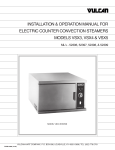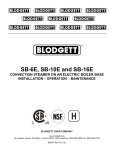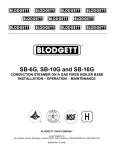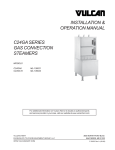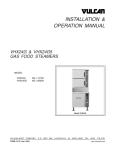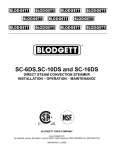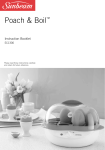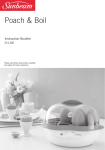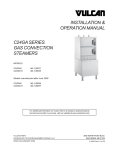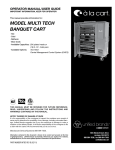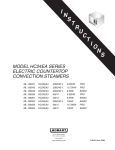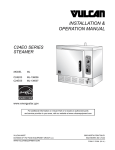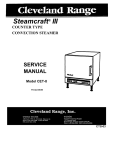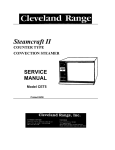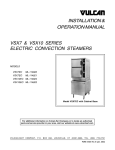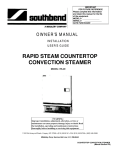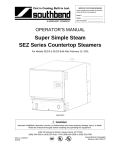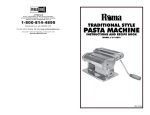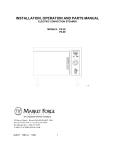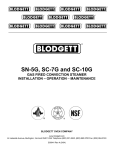Download Hobart HSF3 User's Manual
Transcript
I N S T R U C T Steamer I O N S MODEL HSF SERIES COUNTERTOP CONVECTION STEAMERS MODELS TOTAL KW ML's HSF3 7.5 KW HSF3 10.0 KW HSF4 10.0 KW HSF5 15.0 KW 52400 52804 52401 52805 52402 52819 52403 52821 with Deliming Light with Deliming Light with Deliming Light with Deliming Light 701 S. RIDGE AVENUE TROY, OHIO 45374-0001 FORM 34055 Rev. A (2-99) TABLE OF CONTENTS GENERAL ............................................................................................................................................ 3 INSTALLATION .................................................................................................................................... 3 Unpacking ................................................................................................................................. 3 Location .................................................................................................................................... 3 Leveling Feet or 4" Adjustable Legs ....................................................................................... 3 Leveling .................................................................................................................................... 4 Anchoring Streamer (Without Legs) ........................................................................................ 4 Stacking Kit .............................................................................................................................. 4 Electrical Connections ............................................................................................................. 4 Plumbing Connections ............................................................................................................. 5 Drain Connections ................................................................................................................... 5 Water Quality ............................................................................................................................ 6 Vent Hood ................................................................................................................................. 6 Testing Procedure .................................................................................................................... 7 OPERATION ........................................................................................................................................ 8 Controls .................................................................................................................................... 8 Preheat ..................................................................................................................................... 8 Cook .......................................................................................................................................... 9 Shutdown .................................................................................................................................. 9 Cooking Hints ........................................................................................................................... 9 Draining Steam Generator ..................................................................................................... 10 Cleaning .................................................................................................................................. 10 Cooking Guidelines ................................................................................................................ 12 Cooking In Solid Pans ........................................................................................................... 12 Cooking in Perforated Pans .................................................................................................. 13 MAINTENANCE ................................................................................................................................. 15 Removal of Lime Scale Deposits .......................................................................................... 15 Cold Water Condenser .......................................................................................................... 16 Service .................................................................................................................................... 16 © HOBART CORPORATION, 1992, 1998 –2– INSTALLATION, OPERATION, AND CARE OF MODELS HSF3, HSF4, & HSF5 COUNTERTOP CONVECTION STEAMERS PLEASE KEEP THIS MANUAL FOR FUTURE USE GENERAL The HSF 3, 4, and 5 Steamers are single compartment pressureless steam cookers with an internal electric steam generator that maintains water temperature at approximately 205°F (96°C). HSF3 is rated 7.5 KW as standard; 10 KW is optional. HSF4 is rated 10 KW. HSF5 is rated 15 KW. At high altitude locations a lower temperature is required to achieve atmospheric steaming. Contact your local Hobart-authorized service office to have the thermostat adjusted if the steamer will be operated at high altitudes. INSTALLATION UNPACKING Immediately after unpacking the steamer, check for possible shipping damage. If the steamer is found to be damaged after unpacking, save the packaging material and contact the carrier within 15 days of delivery. Prior to installation, verify that the electrical service agrees with the specifications on the machine data plate which is located on the left side panel. LOCATION Allow space for plumbing and electrical connections. Minimum clearances are 2" (5 cm) on the sides and 6" (15 cm) on the back for proper air circulation. Allow adequate access for operating and servicing the steamer (36" [91 cm] at the front of the steamer and 15" [38 cm] above the steamer). LEVELING FEET (STANDARD) OR 4" (10 CM) ADJUSTABLE LEGS (OPTIONAL) Thread the four 2" (5 cm) leveling feet, shipped in a bag inside the steamer cabinet, into the threaded holes on the bottom corners of the steamer. Or, thread the four optional 4" (10 cm) adjustable legs into the threaded holes on the bottom corners of the steamer. –3– LEVELING 1. Install the racks and place a spirit level or pan of water on a rack in the steamer. 2. Adjust the leveling feet or the feet on the adjustable legs to level the steamer front-to-back and side-to-side. 3. After the drain is connected, check for level by pouring water onto the floor of the compartment. • All water should drain through the opening at the back of the compartment cavity. ANCHORING STEAMER (WITHOUT LEGS) 1. Place steamer in the desired location on the leveled counter top and mark four corners. 2. Remove the steamer and drill 1/2" (1.3 cm) holes as indicated in Fig. 1. 3. Apply a bead of RTV or other equivalent sealant around the bottom perimeter edge of the steamer. If anchoring the steamer, this bottom seal is necessary to meet NSF requirements. 4. Set steamer on counter and bolt down securely with 3/8 - 16 bolts (not supplied). 1 7/8" (4.8 cm) 20" (50.8 cm) Drill 1/2" (1.3cm) holes through counter top 27 3/8" (69.5 cm) 23 3/8" (59.4 cm) Mark 4 corners on counter top PL-53052 23 3/4" (60.3 cm) Fig. 1 STACKING KIT Follow instructions in the stacking kit when installing stacked convection steamers. ELECTRICAL CONNECTIONS WARNING: ELECTRICAL AND GROUNDING CONNECTIONS MUST COMPLY WITH APPLICABLE PORTIONS OF THE NATIONAL ELECTRICAL CODE AND/OR OTHER LOCAL ELECTRICAL CODES. WARNING: DISCONNECT ELECTRICAL POWER SUPPLY AND PLACE A TAG AT THE DISCONNECT SWITCH INDICATING THAT YOU ARE WORKING ON THE CIRCUIT. The wiring diagram is located on the right side panel as you face the steamer. –4– ELECTRICAL DATA Rated Amps Kilowatts Per Phase 3 Phase 1 Phase Amps Per Line Wire Amps L1 - L2 L2 - L3 L1 - L3 L1 L2 L3 Fuse Size or Circuit Size Circuit Breaker Size * (Amps) (Amps) 90°C Copper Wire Size Total KW Volts / Hz / Ph 7.5 208 / 60 / 1 7.5 240 / 60 / 1 45 45 8 7.5 208 / 60 / 3 2.5 2.5 2.5 21 21 21 30 30 10 7.5 240 / 60 / 3 2.5 2.5 2.5 18 18 18 25 25 14 7.5 480 / 60 / 3 2.5 2.5 2.5 9 9 9 15 15 16 10 208 / 60 / 1 48 60 60 8 10 240 / 60 / 1 42 60 60 8 10 208 / 60 / 3 3.3 3.3 3.3 28 28 28 35 35 10 10 240 / 60 / 3 3.3 3.3 3.3 24 24 24 35 35 10 10 480 / 60 / 3 3.3 3.3 3.3 12 12 12 15 15 16 15 208 / 60 / 1 72 90 90 6 15 240 / 60 / 1 63 90 90 6 15 208 / 60 / 3 5 5 5 42 42 42 60 60 8 15 240 / 60 / 3 5 5 5 36 36 36 50 50 8 15 480 / 60 / 3 5 5 5 18 18 18 25 25 14 36 31 50 50 8 * Dual Element Time-Delay Fuse or Inverse Time Circuit Breaker Circuit Size (Minimum) & Fuse/Circuit Breaker Size (Maximum) compiled in accordance with the National Electrical Code ANSI/NFPA 70 (latest edition). PLUMBING CONNECTIONS WARNING: PLUMBING CONNECTIONS MUST COMPLY WITH APPLICABLE SANITARY, SAFETY AND PLUMBING CODES. 1. Connect the water supply line to the two 3/8" copper tube inlets as identified at the rear of the steamer. 2. Install the line strainer provided in the steam generator fill line. • Provide a manual shutoff valve convenient to the steamer for descaling. DRAIN VENT BY CUSTOMER DRAIN CONNECTIONS The drain connection (Fig. 2) must be: • 1" IPS (iron pipe size) down, preferably with one elbow only. • Maximum length of 6 feet (1.8 m). • Piped to an open gap type drain. CAUTION: In order to avoid any back pressure in the steamer, do not connect solidly to any drain connection. 20 (500) MIN. 2 (500) 1 1/4 NPT TO OPEN GAP DRAIN PL-50880 BY CUSTOMER Fig. 2 –5– WATER QUALITY The water supply should be analyzed to make sure specifications are met. Water Supply Specifications Supply Pressure 20 - 80 psig Hardness 2 - 4 grains per gallon Chloride Less than 30 ppm PH Range 7-8 *17.1 ppm = 1 grain of hardness Water supplies vary from one location to another. A local water treatment specialist should be consulted before installing any steam generating equipment. Untreated water contains scale producing minerals which can precipitate onto the surfaces in the steam generator. Due to the temperatures in the steam generator, the minerals can bake onto the surfaces and components. This can result in early component failure and reduced product life. Mineral scale on components causes several problems: 1. The surfaces of the heating devices become coated with scale, reducing the heat transfer efficiency. This can produce hot spots on the heating elements and result in premature failure. 2. The water level probes become coated with scale. Scale will bridge across the probe insulator from the metal extension which senses the water level in the steam generator shell. Once this scale becomes wet, the water level control is unable to maintain the proper water level in the steam generator. This situation may cause an electric heating element to fail if the element is not adequately covered by water. Strainers and filters will NOT remove minerals from the water. Sensors in the steam generator tank use ions in the water to detect the water level. Do not use distilled (fully demineralized or deironized) water. This could provide a false reading to the sensors. Refer to REMOVAL OF LIME SCALE DEPOSITS, page 15. VENT HOOD Some local codes may require the steamer to be located under an exhaust hood. Information on the construction and installation of ventilating hoods may be obtained from the standard for "Vapor Removal from Cooking Equipment," NFPA No. 96 (latest edition), available from the National Fire Protection Association, Batterymarch Park, Quincy, MA 02269. –6– TESTING PROCEDURE WARNING: THE STEAMER AND ITS PARTS ARE HOT. USE CARE WHEN OPERATING, CLEANING OR SERVICING THE STEAMER. THE COOKING COMPARTMENT CONTAINS LIVE STEAM. STAY CLEAR WHILE OPENING THE DOOR. Once the steamer is installed and all mechanical connections have been made, thoroughly test the steamer before operation. 1. Check that proper water, drain, and electrical connections have been made. 2. Close compartment door. 3. Open water valve. 4. Turn main power switch ON. 5. After approximately 15 minutes, the READY light should come on, indicating that the water temperature is 205°F (96°C). 6. When the READY light comes on, turn the dial timer to 5 minutes. 7. Open compartment door — observe that no steam is entering the compartment and the COOKING light is not lit. 8. Close compartment door. The COOKING light is lit and steam should be heard entering the compartment. 9. Check drain line to ensure that water from the cold water condenser is flowing through the drain line. 10. Open compartment door and observe that steam supply to the compartment is cut off. 11. The READY light comes on; the COOKING light goes off. 12. Close compartment door and let cooking cycle finish. 13. When timer returns to 0, a buzzer will sound signalling the end of the cooking cycle. 14. To silence the buzzer, turn the dial timer to OFF. 15. To turn the steamer off: a. Turn the main power switch OFF — the steam generator will drain. b. Open the compartment door to allow the inside to dry out. –7– OPERATION WARNING: THE STEAMER AND ITS PARTS ARE HOT. USE CARE WHEN OPERATING, CLEANING OR SERVICING THE STEAMER. THE COOKING COMPARTMENT CONTAINS LIVE STEAM. STAY CLEAR WHEN OPENING DOOR. CONTROLS Main Power Switch ON Automatically fills steam generator and begins heating to the preset temp. OFF Drains steam generator. DELIME Closes drain valve while CLR liquid is being poured into the generator during the Delime procedure, and resets delime solid state timer. * Ready Light Indicates temperature has reached 205°F (96°C) and the steamer is ready to begin cooking. Cooking Light Indicates that a cooking cycle is in progress. Timer Sets cooking time (0 to 60 minutes). 1. Steam cooking will begin when the door is closed. 2. The cooking cycle will be interrupted if the door is open during the cooking cycle; resume cooking by closing the door. 3. When done, a buzzer sounds and steam stops being supplied to the cooking compartment. 4. Turn the timer OFF to stop the buzzer. Delime Generator Light Indicates that lime scale deposits may have accumulated in the steam generator and that a delime procedure needs to be performed at the next convenient opportunity. * * These features are included on some steamers. See REMOVAL OF LIME SCALE DEPOSITS, page 15. PREHEAT This should be done when the steamer is first used for the day or whenever the compartment is cold. The door should be closed during the preheat cycle. 1. Turn the main power switch ON. 2. When the READY light comes on, set the timer to 1 minute to preheat the compartment. • COOKING light is lit. 3. When the buzzer sounds, turn the timer to OFF. 4. The steamer is now ready to cook. –8– COOK 1. After the preheat cycle, the READY light should be on. 2. Place pans of food in the cooking compartment. 3. Close the door. 4. Set the timer. • Steam flows into the compartment and the COOKING light is lit. • Opening the door will interrupt cooking; resume by closing the door. 5. At the end of the cooking cycle: a. COOKING light goes off. b. Buzzer sounds. c. Steam stops being supplied to the cooking compartment. 6. To stop the buzzer, turn the timer to OFF. SHUTDOWN 1. Turn the main power switch OFF — the steam generator will automatically blow down. 2. Leave the compartment door open to allow the inside to dry out. Extended Shutdown 1. Turn the main power switch OFF. 2. Turn off power and water supply. COOKING HINTS • • • • The steamer efficiently cooks vegetables or other foods for immediate serving. Steam cooking should be carefully time controlled. Keep hot food holding-time to a minimum to produce the most appetizing results. Prepare small batches, cook only enough to start serving, then cook additional amounts to meet demand. Preparation Prepare vegetables, fruits, meats, seafood and poultry normally by cleaning, separating, cutting, removing stems, etc. Cook root vegetables in a perforated pan. Other vegetables may be cooked in a perforated pan unless juices are being saved. Liquids can be collected in a solid 12" x 20" (30 x 50.8 cm) pan placed under a perforated pan. Perforated pans are used for frankfurters, wieners and similar items when juices do not need to be preserved. –9– Solid pans are good for cooking puddings, rice, and hot breakfast cereals. Vegetables and fruits are cooked in solid pans in their own juice. Meats and poultry are cooked in solid pans to preserve their juice or retain broth. Canned foods can be heated in their opened cans (cans placed in 12" x 20" [30 x 50.8 cm] solid pans) or the contents may be poured into solid pans. DO NOT place unopened cans in the steamer. Frozen Food Items Separate frozen foods into smaller pieces to allow more efficient cooking. Use a pan cover for precooked frozen dishes that cannot be cooked in the covered containers that they are packed, if they require more than 15 minutes of cooking time. When a cover is used, approximately one-third additional cooking time is necessary. Cooking time for frozen foods depends on the amount of defrosting required. If time permits, allow frozen foods to partially thaw overnight in a refrigerator. This will reduce their cooking time. Acceptable Pan Sizes The steamer accommodates combinations of 12" x 20" (30 x 50.8 cm) pans, solid or perforated. Number of Pans Accommodated Depth of Pan Model 1" (2.5 cm) 2.5" (6 cm) 4" (10 cm) 6" (15 cm) HSF3 HSF4 HSF5 6 8 10 3 4 5 2 2 3 1 2 2 DRAINING STEAM GENERATOR Drain the steam generator after each day's use to flush out minerals and minimize scale build-up. The steam generator drains automatically for approximately 4 – 6 minutes after the main power switch is turned OFF. CLEANING At the end of each day, or between cooking cycles if necessary . . . 1. Turn main power switch OFF. 2. Remove pans and racks from compartment and wash in sink. 3. Wash compartment interior with clean water. • Never use steel wool or abrasive scouring pads. They will scratch and ruin the general surface appearance of the steamer. – 10 – 4. Clean the door gasket with a cloth or sponge and warm soapy water. a. Rinse with warm clear water. b. Wipe with a dry cloth. 5. Wipe surfaces which touch the door gasket with a cloth or sponge and warm soapy water. a. Rinse with warm clear water. b. Wipe with a dry cloth. CAUTION: Do not allow the door gasket to come in contact with food oils, petroleum solvents, or lubricants. 6. Keep the cooking compartment drain working freely. After cooking foods that produce grease: • Operate the steamer with the compartment empty for 30 minutes at the end of the day. — or — • Pour 1/2 gallon (1.9 liters) of warm soapy water down the drain, followed by 1/2 gallon (1.9 liters) of warm clear water. 7. Use a clean damp cloth to wipe down the exterior of your steamer. 8. Leave the door slightly open when the steamer is not in use to allow the inside to dry out. Weekly, or more often if necessary . . . 1. Turn off main power supply. 2. Turn off main water supply. 3. Clean exterior with a damp cloth and polish with a soft dry cloth. 4. Use a non-abrasive cleaner to remove discolorations. 5. Clean the strainer screen: a. Locate strainer on the back right side of the steamer as you face the front. b. Using a wrench, unscrew the part of the strainer where the strainer screen is located (Fig. 3). c. Take out the strainer screen. d. Clean strainer screen in warm soapy water and rinse. e. Replace strainer screen if damaged. f. Put strainer screen in strainer and tighten strainer using a wrench. STRAINER SCREEN PL-41149-1 Fig. 3 – 11 – COOKING GUIDELINES These cooking guidelines are suggestions only. You should experiment with your food products to determine the cooking times that will give you the best results. Variables which affect cooking time: • size • weight • thickness of foods • temperature • • • • density elevation degree of doneness desired previous condition of the food (fresh, pre-blanched or frozen) COOKING IN SOLID PANS PRODUCT TIME (minutes) WEIGHT PER PAN 10 – 12 8 Doz. 25 2 Lb. (.9 kg) Eggs Scrambled Rice Long Grain (Cover with 4 cups water per pound.) Pasta (Place perforated pan inside solid pan, cover pasta with cold water) Spaghetti, Regular / Vermicelli Macaroni, Shells/Elbows Noodles, 1/ 2" (1.3 cm) wide Lasagna Noodles 12 15 12 15 – – – – 15 18 15 18 Frozen Casseroles Lasagna 35 Full Pan Meat Loaf 3-5 pound (1.4-2.3 kg) each 40 15 Lb. (6.8kg) 20 – 25 35 – 40 10 Lb. (4.5 kg) 10 Lb. (4.5 kg) Seafood Shrimp, Frozen, 10 per pound 5 4 Lb. (1.8 kg) Vegetables Beans Baked Refried 9 9 10 Lb. (4.5 kg) Can 10 Lb. (4.5 kg) Can Canned Vegetables 6 10 Lb. (4.5 kg) Can Beef Ground Chuck Sliced as Purchased Prunes Dried 12 – 15 – 12 – COOKING IN PERFORATED PANS PRODUCT TIME (minutes) WEIGHT PER PAN 10 – 12 5–6 3 Doz. 3 Doz. 4 4–6 6 5 5 4 3–5 21/2 Lb. (1.1 kg) 41/2 Lb. (2 kg) 10 Lb. (4.5 kg) 4 Per Pan 71/2 Lb. (3.4 kg) 3 Lb. (1.4 kg) 4 Lb. (1.8 kg) 10 – 12 5 3 Doz. 5 Lb. (2.3 kg) Seafood Clams Frozen Fresh, Cherrystone King Crab, Frozen Claws Legs Lobster Tail, Frozen Lobster Live, 10-12" (25.4-30.5 cm) Salmon Fillets Frozen, 8 oz (227 g) each Scallops, Fresh Scrod Fillets, Fresh Vegetables Asparagus Spears Frozen Fresh Beans Green, 2" (5 cm) Cut, Frozen / Fresh Lima, Frozen Baby Lima, Frozen Brussel Sprouts, Frozen Broccoli Spears, Frozen Spears, Fresh Flowerettes, Frozen Cabbage, Fresh, 1/6 Cut Carrots Baby Whole, Frozen Crinkle Cut, Frozen Sliced, Fresh Cauliflower, Flowerettes Frozen Fresh Celery, 1" (2.5 cm) Diagonal Cut Corn Yellow Whole Kernel, Frozen Cobbettes, Frozen Corn-On-Cob, Fresh Peas, Green Potatoes, Whole Russet Spinach Chopped, Frozen Defrosted Fresh Cut Squash, Acorn Halves Zucchini, Slices Frozen Mixed Vegetables 6 8 5 6 5 5 5 5 Lb. Lb. Lb. Lb. (2.3 (2.3 (2.3 (2.3 kg) kg) kg) kg) 8 6 6 8 4 5 5 5 Lb. Lb. Lb. Lb. (1.8 (2.3 (2.3 (2.3 kg) kg) kg) kg) 8 7–8 11 7 Lb. (3.2 kg) 4 Lb. (1.8 kg) 9 Lb . (4 kg) 6 7–8 7 4 Lb. (1.8 kg) 5 Lb. (2.3 kg) 5 Lb. (2.3 kg) 5 8 16 – 18 10 – 12 16 – 18 6 55 5 Lb. (2.3 kg) 27 Ears 80 Ears 18 Ears 54 Ears 5 Lb. (2.3 kg) 40 Lb. (18 kg) 17 5 3 25 8 6–7 – 13 – 6 Lb. (2.7 kg) 6 Lb. (2.7 kg) 2 Lb. (.9 kg) 10 Halves 10 Lb. (4.5 kg) 5 Lb. (2.3 kg) (Continue...) COOKING IN PERFORATED PANS (CONT'D) PRODUCT TIME (minutes) Fruit Grapefruit, Oranges, Blanch for Peeling Pineapple, Whole for Cutting WEIGHT PER PAN 3 4 Eggs Hard Cooked Soft Cooked Soft Yoke for Caesar Salad 15 9 – 10 6–8 4 Doz. 4 Doz. 4 Doz. Chicken Breasts, Legs, Thighs 20 15 Lb. (6.8 kg) Turkey, Frozen Breasts (2) Cut Lengthwise 90 55 6-7 Lb. (2.7-3.2 kg) Each 20-25 Lb. (9-11.3 kg) 40 – 75 6-8 Lb. (2.7-3.6 kg) 3 80-100 Count Corned Beef Hot Dogs or Wieners – 14 – MAINTENANCE WARNING: THE STEAMER AND ITS PARTS ARE HOT. USE CARE WHEN OPERATING, CLEANING OR SERVICING THE STEAMER. THE COOKING COMPARTMENT CONTAINS LIVE STEAM. STAY CLEAR WHEN OPENING DOOR. REMOVAL OF LIME SCALE DEPOSITS Steamers equipped with a Delime Generator Light. • Steamer should be delimed at a convenient time after the Delime Generator Light comes on. Steamers without a Delime Generator Light. • Steamer should be delimed once a month, or more often if necessary, if a build-up of lime scale deposits is present. Deliming and Cleaning Steamer Use the CLR Treatment Kit available from your Hobart-authorized service office. The following instructions only apply when using the CLR Treatment Kit to delime the steam generator. Instructions are also available when you purchase the CLR Treatment Kit. WARNING: READ AND FOLLOW THE INSTRUCTIONS ON THE CLR BOTTLE. USE PLASTIC OR RUBBER GLOVES TO AVOID SKIN CONTACT. IF CLR LIQUID COMES IN CONTACT WITH THE SKIN, RINSE WITH CLEAN WATER. STEP 1. Turn the main power switch OFF to drain the steam generator. Set the cooking timer to zero. If there is a Delime Generator Light, turn the main power switch to DELIME. STEP 2. If the Deliming Plug is inside the cooking compartment (Fig. 4), unscrew the plug so the hole points upwards. ALTERNATE STEP 2. If the Deliming Plug is outside on the left side panel (Fig. 5), remove the top plug and turn the main power switch ON. BEAKER FUNNEL Left Side Panel Deliming Plug Drain Plug PL-50823 PLASTIC TUBE DELIMING PLUG PL-51511 Fig. 5 Fig. 4 – 15 – STEP 3. Insert the plastic tube in the deliming port. Connect the funnel to the other end of the tube. Pour 28 fl.oz. of CLR liquid into the generator slowly to avoid spillage. Remove tube and funnel. Thoroughly rinse the tube, funnel, and beaker before storing or disposing. Replace deliming plug so it seals tightly. STEP 4. Turn main power switch ON (if not previously done in Alternate Step 2 above). When READY light comes on, wait 11/2 hours. Turn main power switch OFF and allow to drain. STEP 5. Turn main power switch ON. When the READY light comes on, turn main power switch OFF to drain. Repeat this step three times to completely flush generator. STEP 6. Clean exterior and interior. Use a mild solution of soap and water. Rinse with clean water. Dry with a soft cloth. Leave compartment door open when not in use. The steamer is now ready for use or can be turned off for overnight shutdown. COLD WATER CONDENSER The steamer is equipped with a cold water condenser in the rear of the cooking compartment which helps to condense the steam prior to discharge into the drain. The steamer freely vents itself by the negative pressure created by the condensate water drainage. This negative pressure prevents steam leakage around the door gasket and helps draw the steam through the cooking compartment. Steam leakage at the door may indicate a plugged or improperly installed drain. SERVICE Contact your local Hobart-authorized service office for any repairs or adjustments needed on this equipment. FORM 34055 Rev. A (2-99) – 16 – PRINTED IN U.S.A.
















